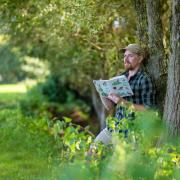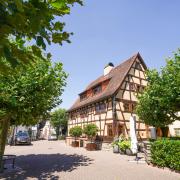Behind the beach at Dawlish lies one of the most important wildlife sites in Devon
Behind the beach at Dawlish lies one of the most important wildlife sites in Devon
On a summer’s day, the beach at Dawlish Warren can be speckled with people paddling, making sandcastles, yet just behind lie over 500 acres of sand dunes, ponds and mud that make up the second most important site for wildlife in the county. Whilst the beach visitors relax, Senior Ranger Phil Chambers and his two colleagues will probably be showing a group around the reserve. From local primary schools to universities, youngsters come to learn about this fast-changing landscape of sand dunes and how Teignbridge rangers balance the management of these fragile habitats next to a beach that attracts 850,000 visitors per year. It’s no wonder that Dawlish Warren is on the GCSE National Curriculum for Geography, and attracts 120 school visits annually! Like them, I took time to explore this wonderful natural space and found out more from Phil. Dawlish Warren is based on a spit; a long sand tongue curling out into the Exe Estuary, formed by the confluence of river and sea. From its tip, you have close-up views of Exmouth. On the sheltered inner side, golfers play on a full 18-hole course, which is also part of the reserve. Over a mile long but only 50 metres wide in places, the sand and gravel spit is in a state of constant flux. Unpredictable and dynamic, this fragile, mobile environment of sand dunes, together with ponds and estuary mud, offers valuable habitats to birds, insects and plants. Though the dunes and ponds are often managed with plants and amphibians in mind, it is still the rare birds that land at the Warren that make the headlines. In 2006 it was a murrelet, a North Korean bird blown off course. Phil explained that estuary mud can contain as many organisms per square metre as a tropical rainforest. For wading birds that make annual journeys across the globe each year, this rich restaurant is well worth a detour. If undisturbed, birds like curlews that migrate from Siberia to Africa each autumn, can rest and build up strength for the next leg of their journey south.
On a summer’s day, the beach at Dawlish Warren can be speckled with people paddling, making sandcastles, yet just behind lie over 500 acres of sand dunes, ponds and mud that make up the second most important site for wildlife in the county.
Whilst the beach visitors relax, Senior Ranger Phil Chambers and his two colleagues will probably be showing a group around the reserve. From local primary schools to universities, youngsters come to learn about this fast-changing landscape of sand dunes and how Teignbridge rangers balance the management of these fragile habitats next to a beach that attracts 850,000 visitors per year. It’s no wonder that Dawlish Warren is on the GCSE National Curriculum for Geography, and attracts 120 school visits annually! Like them, I took time to explore this wonderful natural space and found out more from Phil.
Dawlish Warren is based on a spit; a long sand tongue curling out into the Exe Estuary, formed by the confluence of river and sea. From its tip, you have close-up views of Exmouth. On the sheltered inner side, golfers play on a full 18-hole course, which is also part of the reserve. Over a mile long but only 50 metres wide in places, the sand and gravel spit is in a state of constant flux. Unpredictable and dynamic, this fragile, mobile environment of sand dunes, together with ponds and estuary mud, offers valuable habitats to birds, insects and plants.
Though the dunes and ponds are often managed with plants and amphibians in mind, it is still the rare birds that land at the Warren that make the headlines. In 2006 it was a murrelet, a North Korean bird blown off course.
Phil explained that estuary mud can contain as many organisms per square metre as a tropical rainforest. For wading birds that make annual journeys across the globe each year, this rich restaurant is well worth a detour. If undisturbed, birds like curlews that migrate from Siberia to Africa each autumn, can rest and build up strength for the next leg of their journey south.
Visit and learn Dawlish Warren Visitor Centre is open from 1 April – 31 August. Junior Ranger activities are free and on 19 June, children can see Dawlish Warren’s small world on the big screen through a video microscope.
Visit and learnDawlish Warren Visitor Centre is open from 1 April – 31 August. Junior Ranger activities are free and on 19 June, children can see Dawlish Warren’s small world on the big screen through a video microscope.
Sand dune specialityThe diminutive sand crocus (or warren crocus) attracts botanists from all over the UK as this reserve is only one of two places you can find it in Britain.
Teignbridge rangers balance the management of these fragile habitats next to a beach that attracts 850,000 visitors per year
In June, a quiet time in the birding calendar, there are still oystercatchers to see, whilst amongst the wetlands and sand dunes where you may spot whitethroat, stonechat and willow warblers. Conserving wildlife isn’t just a case of fencing it off or leaving it alone. Where certain habitats are now rare, active management is needed to keep the site at an optimal stage for threatened species to thrive.
Balancing the needs of wildlife and allowing people to enjoy and, importantly, understand the site is no easy task: “We might be clearing scrub by hand, sawing down invasive trees in winter, pulling ragwort in summer, or clearing the ponds of weed to maintain open water – in between guiding groups around the site,” he explained. For Phil, inspiring the next generation is the most rewarding work of all. Twitching in town Head to Dawlish town centre if you fancy seeing some waterfowl from far-flung parts. Most famous are the black swans, who are the town’s emblem. Brought here from New Zealand over 100 years ago by Dawlish-born John Nash, they are the prima donnas of the park (known as The Lawns), which runs right through the middle of town. Their nests are protected by fences, and their cygnets from attacks by seagulls, dogs and even otters, in a special aviary enclosure sandwiched between the road and the tumbling stream that runs through The Lawns. In recent years an array of ducks and geese have been added, including barnacle geese, crested ducks with bouffant hair-dos and shimmering blue bottle green East India ducks. Derek Porter is employed by the town council as Duck Warden, and told me how he looks after all the waterfowl in town, especially the nine black swans who are all descendants of the original pair. Nurturing the swans’ eggs from when they are laid in January to when they hatch 38 days later, he’s a proud carer of the gangly, grey cygnets who will continue Dawlish’s line of black swans. Rabbits The sand dunes have been a warren since 1280 when rabbits were kept and bred here as a luxury food for the rich. Grazing the grass low and nibbling out invasive plants kept conditions just right for small, rare sand dune plants and grasses to flourish. Myxamatosis, followed by viral haemorrhagic disease, reduced the Warren’s rabbit population by 75%. To keep the rare plants, reserve wardens have to replicate the effect of the rabbits grazing by mowing the grass and grazing it with Dartmoor ponies in winter. The village that vanished The Warren is constantly shifting its shape. At the turn of the century, the spit was a very different shape to today. Then locals built holiday homes; eccentric wooden bungalows; a whole ‘village’ with a caf�, shop and ferry to Exmouth. The dredging of thousands of tons of gravel near Starcross only accelerated the natural process of dune movements, and every few years an autumn storm would wash several houses away until fierce storms in 1946 removed the last of the Warren’s homes.
RabbitsThe sand dunes have been a warren since 1280 when rabbits were kept and bred here as a luxury food for the rich. Grazing the grass low and nibbling out invasive plants kept conditions just right for small, rare sand dune plants and grasses to flourish. Myxamatosis, followed by viral haemorrhagic disease, reduced the Warren’s rabbit population by 75%. To keep the rare plants, reserve wardens have to replicate the effect of the rabbits grazing by mowing the grass and grazing it with Dartmoor ponies in winter. The village that vanishedThe Warren is constantly shifting its shape. At the turn of the century, the spit was a very different shape to today. Then locals built holiday homes; eccentric wooden bungalows; a whole ‘village’ with a caf�, shop and ferry to Exmouth. The dredging of thousands of tons of gravel near Starcross only accelerated the natural process of dune movements, and every few years an autumn storm would wash several houses away until fierce storms in 1946 removed the last of the Warren’s homes.
Munch and observeThere are lots of caf�s and bakeries from which to pick up a picnic and sit amidst the ducks, swans and Persian carpets of flower beds of The Lawns. Alternatively, try a savoury tea of cheese scones, chutney and Westcountry cheese beside the working 15m diameter mill wheel opposite. It takes water from the brook in which the swans swim and offers a lovely vantage point from which to survey the birds.


























